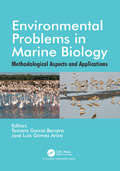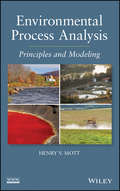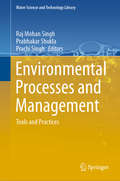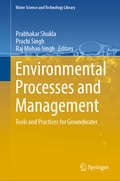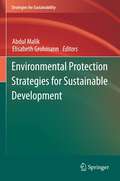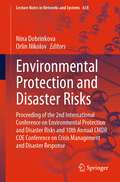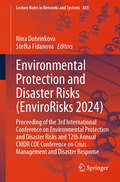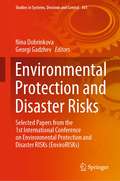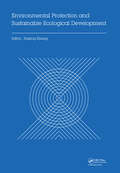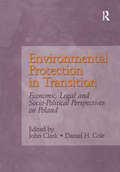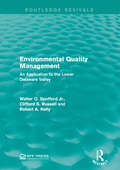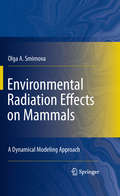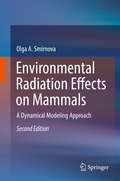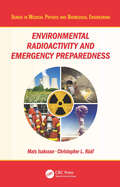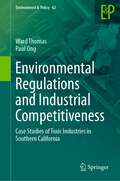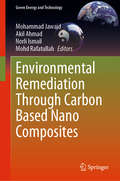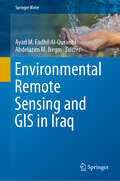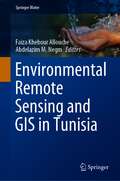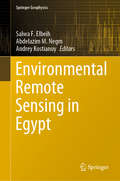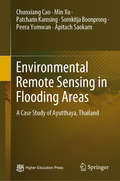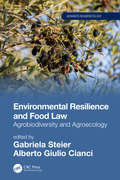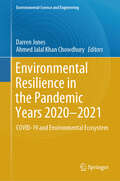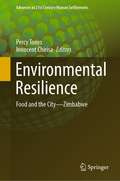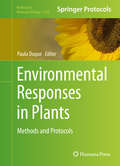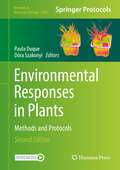- Table View
- List View
Environmental Problems in Marine Biology: Methodological Aspects and Applications
by Tamara Garcia Barrera Jose Luis ArizaMarine environment can be affected by several pollutants such as the presence of elements and their chemical species, pharmaceuticals, nanoparticles and other emerging contaminants. Environmental monitoring can be assessed by genomics, proteomics (i.e. redox proteomics), chemical speciation analysis and metallomics, metabolomics as well as other advanced strategies. The present book is a useful methodological tool for researchers and specialists in the field of analytical chemistry, environmental sciences, biochemistry, genomics and toxicology. The book includes for the first time the methodological aspects and applications related to chemical speciation and –omics strategies applied to marine environment.
Environmental Process Analysis
by Henry V. MottEnables readers to apply core principles of environmental engineering to analyze environmental systemsEnvironmental Process Analysis takes a unique approach, applying mathematical and numerical process modeling within the context of both natural and engineered environmental systems. Readers master core principles of natural and engineering science such as chemical equilibria, reaction kinetics, ideal and non-ideal reactor theory, and mass accounting by performing practical real-world analyses. As they progress through the text, readers will have the opportunity to analyze a broad range of environmental processes and systems, including water and wastewater treatment, surface mining, agriculture, landfills, subsurface saturated and unsaturated porous media, aqueous and marine sediments, surface waters, and atmospheric moisture.The text begins with an examination of water, core definitions, and a review of important chemical principles. It then progressively builds upon this base with applications of Henry's law, acid/base equilibria, and reactions in ideal reactors. Finally, the text addresses reactions in non-ideal reactors and advanced applications of acid/base equilibria, complexation and solubility/dissolution equilibria, and oxidation/reduction equilibria.Several tools are provided to fully engage readers in mastering new concepts and then applying them in practice, including:Detailed examples that demonstrate the application of concepts and principlesProblems at the end of each chapter challenging readers to apply their newfound knowledge to analyze environmental processes and systemsMathCAD worksheets that provide a powerful platform for constructing process modelsEnvironmental Process Analysis serves as a bridge between introductory environmental engineering textbooks and hands-on environmental engineering practice. By learning how to mathematically and numerically model environmental processes and systems, readers will also come to better understand the underlying connections among the various models, concepts, and systems.
Environmental Processes and Management: Tools and Practices (Water Science and Technology Library #91)
by Prachi Singh Raj Mohan Singh Prabhakar ShuklaThis book presents an in-depth, science-based approach to applying key project-management and spatial tools and practices in environmental projects. Providing important data for those considering projects that balance social-economic growth against minimizing its ill-effects on planet Earth, the book discusses various aspects of environmental engineering, as well as formula and analytical approaches required for more informed decision-making. Beginning with a broad overview of the factors and features of environmental processes and management, the book then clearly details the general application of fundamental processes, the characteristics of the different systems in which they occur, and the way in which these factors influence process dynamics, environmental systems, and their possible remedies. While primarily intended for professionals responsible for the management of environmental projects or interested in improving the overall efficiency of such projects, it is also useful for managers in the private, public, and not-for-profit sectors. Further, it is a valuable resource for students at both undergraduate and postgraduate levels, and an indispensable guide for anyone wanting to develop their skills in modern environmental management and related techniques.
Environmental Processes and Management: Tools and Practices for Groundwater (Water Science and Technology Library #120)
by Prachi Singh Raj Mohan Singh Prabhakar ShuklaThis book is Volume 2 which is published to complement "Environmental Processes and Management: Tools and Practices" (https://link.springer.com/book/10.1007/978-3-030-38152-3), 2020This book provides an in-depth, well-researched and science-based approach to applying key project management and spatial tools and practices in environmental projects. This book is an important read for leaders considering projects that balance social–economic growth against minimizing its ill effects on Planet Earth. This book brings together several aspects of groundwater engineering, as well as the formula and analytical approaches required for more informed decision-making. It also highlights the vital importance of understanding the technological, economic and social dimensions of environmental studies explained through dynamic approaches and illustrative figures that have short-term results and long-term impacts. This book emphasizes on encouraging the modern and vibrant research works conducted by young researchers across the world. This book clearly details the general application of fundamental groundwater processes, the character of the different types of systems in which they occur and the way in which these factors influence process dynamics, environmental systems and their possible remedies. The book sets a possible recommendation for the professionalism with which environmental research should be planned, executed, monitored, assessed and delivered. While primarily intended for professionals responsible for the management of groundwater projects or interested in improving the overall efficiency of such projects, it is also useful for managers in the private, public and not-for-profit sectors. The book is a valuable resource for students at both undergraduate and postgraduate levels. In addition, this book serves as an indispensable guide for anyone willing to develop their skills in modern groundwater / environmental management and related techniques
Environmental Protection Strategies for Sustainable Development
by Elisabeth Grohmann Abdul MalikThe environment of our planet is degrading at an alarming rate because of non-sustainable urbanization, industrialization and agriculture. Unsustainable trends in relation to climate change and energy use, threats to public health, poverty and social exclusion, demographic pressure and ageing, management of natural resources, biodiversity loss, land use and transport still persist and new challenges are arising. Since these negative trends bring about a sense of urgency, short term action is required, whilst maintaining a longer term perspective. The main challenge is to gradually change our current unsustainable consumption and production patterns and the nonintegrated approach to policy-making. This book covers the broad area including potential of rhizospheric microorganisms in the sustainable plant development in anthropogenic polluted soils, bioremediation of pesticides from soil and waste water, toxic metals from soil, biological treatment of pulp and paper industry wastewater, sustainable solutions for agro processing waste management, solid waste management on climate change and human health, environmental impact of dyes and its remediation. Various methods for genotoxicity testing of environmental pollutants are also discussed and chapters on molecular detection of resistance and transfer genes in the environmental samples, biofilm formation by the environmental bacteria, biochemical attributes to assess soil ecosystem sustainability, application of rhizobacteria in biotechnology, role of peroxidases as a tool for the decolorization and removal of dyes and potential of biopesticides in sustainable agriculture. It offers a unique treatment of the subject, linking various protection strategies for sustainable development, describing the inter-relationships between the laboratory and field eco-toxicologist, the biotechnology consultant, environmental engineers and different international environmental regulatory and protection agencies.
Environmental Protection and Disaster Risks: Proceeding of the 2nd International Conference on Environmental Protection and Disaster Risks and 10th Annual CMDR COE Conference on Crisis Management and Disaster Response (Lecture Notes in Networks and Systems #638)
by Orlin Nikolov Nina DobrinkovaThis book presents topics that are challenging fields that scientific world is trying to address as much as it can. Earthquakes, floods, fires, droughts, blizzards, dust storms, natural releases of toxic gases and liquids, diseases, and other environmental variations affect hundreds of millions of people each year. Many disaster events are triggered by human activities. Dealing with these problems will require systems thinking and integrating multidisciplinary science. Actions in these directions are taken more and more in the recent years by political bodies, NGOs, and scientific groups trying to find sustainable solutions for the future generations. Every point of view matters when it comes to our global home—The Planet Earth. The book presents research findings and conclusions that have been developed as algorithms or new methods solving problems in the fields of disaster management, natural hazards, risk reduction and building resilience, climate change challenges and security implications, air pollution and health, water resources and management and informatics, remote sensing, GIS, and high-performance computing. The 2nd International Conference on Environmental Protection and Disaster Risks in combination with the 10th Annual CMDR COE Conference on Crisis Management and Disaster Response brought together in the period June 06-09, 2022, in Sofia, Bulgaria scientists who presented their findings in the fast developing environmental management and disaster risk reduction field.
Environmental Protection and Disaster Risks: Proceeding of the 3rd International Conference on Environmental protection and Disaster Risks and 12th Annual CMDR COE Conference on Crisis management and Disaster Response (Lecture Notes in Networks and Systems #883)
by Stefka Fidanova Nina DobrinkovaThis book is a comprehensive collection of extended contributions from the 3rd International Conference on Environmental Protection and Disaster Risks and the 12th Annual CMDR COE Conference on Crisis Management and Disaster Response held in the period June 4–6, 2024, in Sofia, Bulgaria, as a hybrid participation event. Environmental protection and disaster risk topics are challenging fields, that scientific world is trying to address. Earthquakes, floods, fires, droughts, blizzards, dust storms, natural releases of toxic gases and liquids, diseases, and other environmental variations affect hundreds of millions of people each year. Many disaster events are triggered by human activities. Dealing with these problems requires a multidisciplinary scientific approach. Actions in these directions are taken more and more in the recent years by political bodies, NGOs, and scientific groups trying to find sustainable solutions for the future generations. Every point of view matters when it comes to our global home—The Planet Earth. This book presents recent advances in the topics: disaster management, natural hazards, risk reduction, and building resilience; climate change challenges and security implications; resilience and business continuity management; high-performance computing, modeling and simulations, GIS for environmental monitoring and artificial intelligence. The book is focused on important large-scale applications like environmental and climate modeling, computational optimizations and algorithms for specific hazard situations analyses.
Environmental Protection and Disaster Risks: Selected Papers from the 1st International Conference on Environmental Protection and Disaster RISKs (EnviroRISKs) (Studies in Systems, Decision and Control #361)
by Nina Dobrinkova Georgi GadzhevThis book presents research findings and conclusions that has been developed as algorithms or intelligent new methods solving problems in the fields of air pollution, climate and health, natural hazards and risks, water resources, human activities and management and informatics, remote sensing, high-performance computing and GIS for environmental monitoring and management. Environmental protection and disaster risk topics are challenging fields, that scientific world is trying to address as much as it can. Earthquakes, floods, fires, droughts, blizzards, dust storms, natural releases of toxic gases and liquids, diseases and other environmental variations affect hundreds of millions of people each year. Many disaster events are triggered by human activities. Dealing with these problems will require systems thinking and integrating multidisciplinary science. Actions in these directions are taken more and more in the recent years by political bodies, NGOs and scientific groups trying to find sustainable solutions for the future generations. Every point of view matter when it comes to our global home – The Planet Earth.
Environmental Protection and Sustainable Ecological Development: Proceedings of the 2014 International Conference on Environmental Protection and Sustainable Ecological Development (EPSED 2014), Wuhan, Hubei, China, October 24-26, 2014
by Jiaxing ZhangThis volume contains the papers presented at the 2014 International Conference on Environmental Protection and Sustainable Ecological Development (EPSED2014). The contributions cover the latest research results and explore new areas of research and development, like Earth Science, Resource Management, Environmental Protection, and Sustainable
Environmental Protection in Transition: Economic, Legal and Socio-Political Perspectives on Poland
by John Clark Daniel H. ColeThis book takes an interdisciplinary look at environmental protection during Poland’s transition to market democracy. The contributors are recognised experts in their fields, making this an authoritative volume, combining the perspectives of economists, legal scholars, political scientists and sociologists.
Environmental Quality Management: An Application to the Lower Delaware Valley (Routledge Revivals)
by Walter O. Spofford Jr. Clifford S. Russell Robert A. KellyEnvironmental Quality Management provides a quantitative analysis of regional residuals environmental quality management in the Lower Delaware Valley. Originally published in 1976, this study takes a management outlook to discuss new systems such as a non-linear aquatic eco-system model and reaches conclusions which have influenced research and management decisions about REQM across the world. This title will be of interest to students of Environmental Studies.
Environmental Radiation Effects on Mammals
by Olga A. SmirnovaThe monograph is devoted to theoretical studies of radiation effects on mammals. It investigates the effects of both acute and chronic irradiation on vital body systems (hematopoiesis, small intestine, and humoral immunity), on the development of autoimmune diseases and on the mortality dynamics in homogeneous and nonhomogeneous (in radiosensitivity) mammalian populations. All are set within the framework of biologically motivated mathematical models. The developed methodology of the studies, the models themselves, and the obtained results are of a great theoretical significance and can find wide practical use for those dealing with the problems of environmental protection and radiation safety.
Environmental Radiation Effects on Mammals
by Olga A. SmirnovaDr. Smirnova's updated text is devoted to the theoretical studies of radiation effects on mammals. It summarizes 35 years of results the author obtained from analyzing dose rate equivalents for the Galactic Cosmic Rays (GCR) and for Solar Particles Events (SPE). This edition also includes two new chapters on skin epidermal epithelium and risk assessment for myeloid leukemia, as well as extended revisions addressing the radiation effects on the blood-forming system. Mathematical models are used to explain the effects of both acute and chronic irradiation on the dynamics of vital body systems, like the hematopoietic system, the development of autoimmune diseases, and the mortality dynamics in homogeneous and nonhomogeneous mammalian populations. The proposed methodology of these studies, the models themselves, and the obtained results are of a great theoretical significance and can find wide practical use.
Environmental Radioactivity and Emergency Preparedness (Series in Medical Physics and Biomedical Engineering)
by Mats Isaksson Christopher L. RaafRadioactive sources such as nuclear power installations can pose a great threat to both humans and our environment. How do we measure, model and regulate such threats? Environmental Radioactivity and Emergency Preparedness addresses these topical questions and aims to plug the gap in the lack of comprehensive literature in this field. The book explores how to deal with the threats posed by different radiological sources, including those that are lost or hidden, and the issues posed by the use of such sources. It presents measurement methods and approaches to model and quantify the extent of threat, and also presents strategies for emergency preparedness, such as strategies for first-responders and radiological triage in case an accident should happen. Containing the latest recommendations and procedures from bodies such as the IAEA, this book is an essential reference for both students and academicians studying radiation safety, as well as for radiation protection experts in public bodies or in the industry.
Environmental Regulations and Industrial Competitiveness: Case Studies of Toxic Industries in Southern California (Environment & Policy #62)
by Ward Thomas Paul OngWhile polluting industries in the U.S. continue to emit billions of pounds of toxic chemicals into the air, land and water every year, many economists and policy makers argue that environmental regulations stifle economic growth and reduce the standard of living for the American people. This book takes a fresh look at this question through three case studies of highly regulated polluting industries in the Southern California region: metal finishing, wood furniture, and dry cleaning. The case studies are based on a mix of qualitative and quantitative methods, including in-depth interviews with corporate managers and environmental regulators. The authors find that there is no universal pattern for predicting the effects of environmental regulations on industrial competitiveness, but that the outcomes depend on the structure of the industry being regulated, the design of the regulations, and the technologies that are available for compliance. The book is written in straight forward language that is accessible to the non-economist and will prove an essential resource for academics and students of all levels, and professionals and policy makers in the fields of environmental policy and regional economic development.
Environmental Remediation Through Carbon Based Nano Composites (Green Energy and Technology)
by Mohammad Jawaid Norli Ismail Akil Ahmad Mohd RafatullahThis book examines carbon-based nanocomposite materials and their application in various environmental fields, such as wastewater treatment, and air and soil remediation. Featuring illustrations, and tables summarizing the latest research, it gathers up-to-date information on the application of carbon nanocomposites in the removal of environmental pollutants from different sources. Given its scope, the book is a valuable textbook for research students, and a useful handbook and reference resource for researchers, academics and industrial scientists working in the field of environmental pollutants and their safe removal.
Environmental Remote Sensing and GIS in Iraq (Springer Water)
by Abdelazim M. Negm Ayad M. Fadhil Al-QuraishiThis unique book focuses on remote sensing (RS) and geographical information systems (GIS) in Iraq. The environmental applications include monitoring and mapping soil salinity and prediction of soil properties, monitoring and mapping of land threats, proximal sensing for soil monitoring and soil fertility, spatiotemporal land use/cover, agricultural drought monitoring, hydrological applications including spatial rainfall distribution, surface runoff and drought control, geo-morphometric analysis and flood simulation, hydrologic and hydraulic modelling and the effective management of water resources. Also, this book assesses the impacts of climate change on natural resources using both RS and GIS, as well as other applications, covering different parts of Iraq. The book chapters include tens of maps extracted from the remotely sensed datasets, in addition to tables and statistical relations obtained from the results of the studies of the chapters' authors. These studies have been conducted in different parts of Iraq; in the north (Kurdistan region) with its mountainous and undulating lands, in western parts which have desert soils, and in central and southern Iraq where there are salty soils, dunes, wetlands, and marshes.The book is written by distinguished scientists from Iraq, China, USA, Italy, Iran, Germany, and the Czech Republic who are interested in the Iraqi environment. The book is therefore a useful source of information and knowledge on Iraqi environment for graduate students, researchers, policy planners, and stakeholders in Iraq as well as similar regions.
Environmental Remote Sensing and GIS in Tunisia (Springer Water)
by Abdelazim M. Negm Faiza Khebour AlloucheThis book focuses on monitoring and assessing various environmental processes in Tunisia using state-of-the-art remote sensing and GIS technologies. In addition to addressing the diversity of Tunisian landscapes and providing spatial analysis of natural, cultivated and urbanized environments. It presents and discusses several case studies on integrated RS / GIS approaches for mapping, modeling, monitoring and evaluation. Moreover, in this volume authored by experts in the topic from Tunisia and other countries, authors assess the agro-environmental applications from Tunisia and offer different methods and applications to environmental processes and risks including drought, degradation, flood, planning, Yield estimation, dust storm detection, dry land vulnerability, wetland dynamics and others. The material presented here will help decision-makers plan sustainable landscape and agricultural management policies that preserve biodiversity and contribute to achieving sustainability goals and for researchers, it will expose methodological approaches used in different fields of research. Graduate students and Practionioner engineers working in the field of RS/GIS will also benefit from the book. The book ends with a set of conclusions and recommendations to support researchers underscoring the need for further research in this area.
Environmental Remote Sensing in Egypt (Springer Geophysics)
by Abdelazim M. Negm Salwa F. Elbeih Andrey KostianoyThis book presents a comprehensive selection of applications employed in environmental remote sensing using optical and thermal infrared satellite-sensors aiming to map natural resources, crops, groundwater, surface water, aquatic ecosystem, land degradation, air quality, renewable energy, regional resources, and climate-related geophysical processes. The technologies presented in this book also include satellite images, space-borne radar sensors focusing on the most versatile one, data from synthetic aperture radar (SAR), scatterometers and radar altimeters in Egypt. This volume also presents a thorough explanation of the remote sensing role showing physical fundamentals of the climate change phenomenon including gas emissions, and the impact on resources concerning the sustainable development of Egypt. Besides, the book includes an analysis of oil pollution in both Mediterranean and Red Seas This book is intended for environmental policymakers working in Egypt as well as scientists working with remote sensing technologies in highly populated arid regions.
Environmental Remote Sensing in Flooding Areas: A Case Study of Ayutthaya, Thailand
by Min Xu Chunxiang Cao Patcharin Kamsing Sornkitja Boonprong Peera Yomwan Apitach SaokarnThis book introduces flood inundation area and flood risks assessment based on a comprehensive monitoring system using remote sensing and geographic information system technologies. Taking the 2011 flood disaster of Ayutthaya in Thailand as an example, it presents a flood intrusion zone identification method based on remote sensing technology, spatial information technology and geographic information system for flood disaster monitoring and early warning system. It introduces the study area and data, vegetation index, improved support vector machine and flood intrusion zone identification method. It also analyzes the flood remote sensing parameters and waterborne diseases, method of risk assessment of waterborne disease outbreak, waterborne disease outbreak risk monitoring based on backpropagation neural network and its expert system. It not only promotes a new interdisciplinary approach both in public health and space information technology, but also greatly supports decision makers in disaster reduction.
Environmental Resilience and Food Law: Agrobiodiversity and Agroecology (Advances in Agroecology)
by Gabriela Steier Alberto Giulio CianciAgrobiodiversity and agroecology go hand-in-hand in promoting environmental resilience in international food systems as well as climate change resilient food policy. This book contextualizes how various legal frameworks address agrobiodiversity and agroecology around the globe and makes it accessible for audiences of students, practitioners, educators, and scholars. Some chapters focus on the legal regulation of agroecology from a food law perspective. Others are geared toward providing regulators, lawmakers and attorneys with the scientific and policy background of those concepts, so that they are equipped in the field of food law in everyday practice and policy. Climate change dimensions of the issues are woven throughout the book.
Environmental Resilience in the Pandemic Years 2020–2021: COVID-19 and Environmental Ecosystem (Environmental Science and Engineering)
by Darren Jones Ahmed Jalal Khan ChowdhuryThis book focuses on the indirect effects on environmental resilience. The COVID-19 epidemic and the 2020 global pandemic have had an unprecedented public health impact. These included not only economic impacts but also social activities, and environmental and ecological impacts. This study examined the fact that net effects were positive, for example, in terms of greenhouse gas emissions, oil and gas exploration activities, and reductions in pollution. The most notable and most positive environmental impact of COVID-19 is the reduction of greenhouse gas emissions from transportation sources. Air and road transport cause a huge portion of the pollution from closures and outages. Restrictions on economic and social mobility have had positive impacts, with reductions in transport and trade contributing significantly to reducing greenhouse gas emissions. By increasing their scale, endangered ecosystems benefit from improved environmental quality. To better understand how the environment is maintained, we summarize the evolution of COVID-19 and subsequent pandemics. The COVID-19 pandemic has had an unexpected and lasting impact on the environment. At the same time, ecological hotspots where human activity is commonly prevalent benefit from improved environmental quality, allowing wildlife and other life forms to thrive. For this reason, we can conclude that the COVID-19 outbreak and subsequent pandemic were beneficial to environmental stewardship.
Environmental Resilience: Food and the City—Zimbabwe (Advances in 21st Century Human Settlements)
by Innocent Chirisa Percy ToriroThis book discusses the production, distribution, regulatory and management frameworks that affect food in urban settings. It plugs a gap in knowledge especially in the sub-Saharan Africa region where food, despite its critical importance, has been ignored as a ‘determinant of success’ in the planning and management of cities and towns. The various chapters in the book demonstrate how urban populations in Zimbabwe and elsewhere have often devised ways to produce own food to supplement on their incomes. Food is produced largely by way of urban agriculture or imported from the countryside and sold in both formal and informal stores and stalls. The book shows how in spite of the important space food occupies in the lives of all city residents, the planning and regulatory framework does not facilitate the better performance of food systems.
Environmental Responses in Plants
by Paula DuqueThis volume describes different up-to-date methodological approaches, ranging from physiological assays to imaging and molecular techniques, to study a wide variety of plant responses to environmental cues. Environmental Responses in Plants: Methods and Protocols is divided into four sections: Tropisms, Photoperiodism and Circadian Rhythms, Abiotic Stress Responses, and Plant-Pathogen Interactions. The chapters in these sections include detailed protocols to investigate some of the many key biological processes underlying plant environmental responses, mostly in the model organism Arabidopsis thaliana, but also in Physcomitrella patens and in different crop species such as rice, potato, barley, or tomato. Written in the highly successful Methods in Molecular Biology series format, chapters include introductions to their respective topics, lists of the necessary materials and reagents, step-by-step, readily reproducible laboratory protocols, and tips on troubleshooting and avoiding known pitfalls. Authoritative and practical, Environmental Responses in Plants: Methods and Protocols, is a great resource for plant physiologists, biochemists, and cell and molecular scientists interested in this exciting and fast-growing research topic.
Environmental Responses in Plants: Methods and Protocols (Methods in Molecular Biology #2494)
by Paula Duque Dóra SzakonyiThis second edition describes up-to-date methodological approaches, ranging from physiological assays to imaging and molecular techniques, to study a wide variety of plant responses to environmental cues. Chapters are divided into four sections detailing protocols to investigate key biological processes underlying plant environmental responses in the model organisms Arabidopsis thaliana and Physcomitrella patens as well as in different crop species. Written in the format of the highly successful Methods in Molecular Biology series, each chapter includes an introduction to the topic, lists necessary materials and reagents, includes tips on troubleshooting and known pitfalls, and step-by-step, readily reproducible protocols. Authoritative and cutting-edge, Environmental Responses in Plants, Second Edition aims to be a foundation for future studies and to be a source of inspiration for new investigations in the field.
